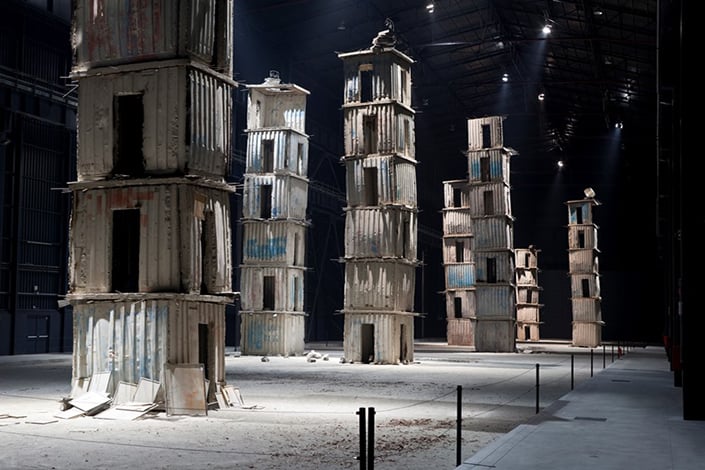Anselm Kiefer – I Sette Palazzi Celesti 2004/2015

Lo spazio che ospita l’installazione permanente de I Sette Palazzi Celesti di Anselm Kiefer, inaugurata nel 2004 in occasione dell’apertura di HangarBicocca, si arrichisce di quattro nuove opere pittoriche di grandi dimensioni e di un’installazione scultorea dell’artista.
Comunicato stampa
Venerdì 25 settembre 2015 (ore 11.00) Hangar Bicocca apre al pubblico una nuova installazione site-specific di Anselm Kiefer. Curato da Vicente Todolí, l’allestimento è un ampliamento de I Sette Palazzi Celesti, opera permanente concepita e presentata per HangarBicocca nel 2004 da un progetto di Lia Rumma. Cinque opere pittoriche di grandi dimensioni, prodotte tra il 2009 e il 2013 e ancora inedite, formeranno insieme alle sette “torri” – oggi rese percorribili al pubblico – un’unica installazione dal titolo I Sette Palazzi Celesti 2004-2015. Le cinque grandi tele – Jaipur (2009); due opere della serie Cette obscure clarté qui tombe des étoiles (2011); Alchemie (2012); Die deutsche Heilslinie (2012-2013) – saranno esposte nello spazio delle “Navate” che accoglie l’installazione permanente, conferendo un nuovo significato al capolavoro di Anselm Kiefer. Le tele richiamano infatti alcuni temi già presenti ne I Sette Palazzi Celesti – le grandi costruzioni architettoniche del passato come tentativo dell’uomo di ascendere al divino e le costellazioni rappresentate attraverso la numerazione astronomica – e aggiungono inoltre alcune riflessioni centrali nella poetica dell’artista, quali la relazione tra uomo e natura, i riferimenti alla storia del pensiero e della filosofia occidentale. Il nuovo riallestimento delle opere di Anselm Kiefer dà avvio, come “progetto speciale”, alla nuova programmazione di HangarBicocca prevista per il triennio 2015-2018 e concepita dal Direttore Artistico Vicente Todolí.
Anselm Kiefer (nato nel 1945 a Donaueschingen, Germania) espone per la prima volta alla Kunstverein di Hannover nel 1969. Negli anni diversi istituzioni internazionali gli dedicano mostre personali e retrospettive: Stedelijk Van Abbemuseum, Eindhoven, Olanda (1979); Musée d’Art Contemporain, Bordeaux, ARC/Musée d’Art Moderne de la Ville de Paris, Parigi (1984); The Art Institute of Chicago, Philadelphia Museum of Art, Philadelphia, MOCA, Los Angeles e MoMA, New York (1987); Neue Nationalgalerie, Berlino (1991); Museo Nacional Centro de Arte Reina Sofía, Madrid, The Metropolitan Museum of Art, New York (1998); Galleria d’Arte Moderna, Bologna (1999); Musée d’Art Contemporain de Montréal, Canada, The Hirshhorn Museum and Sculpture Garden, Washington D.C. e San Francisco Museum of Modern Art (mostra itinerante, 2005-2007); Guggenheim Museum, Bilbao, Musée du Louvre, Parigi (2007); Royal Academy of Arts, Londra (2014). Ha partecipato a due edizioni di Documenta (1977; 1988) e a due edizioni della Biennale di Venezia (1980; 1997). Nel 2007 il Musée du Louvre ha commissionato a Kiefer la realizzazione di un lavoro inedito per la sua collezione permanente e nello stesso anno realizza un’installazione site-specific al Grand Palais di Parigi in occasione di Monumenta.
--
On Friday 25 September 2015 (11am) HangarBicocca unveils the new installation by Anselm Kiefer: the new display, curated by Vicente Todolí, is an expansion of The Seven Heavenly Palaces, the permanent work conceived for the opening of HangarBicocca in 2004 and based on a project by Lia Rumma. Together with the seven “towers” – now open for the public to walk through – five large-format paintings, made between 2009 and 2013 but never shown until now, will form a single installation entitled The Seven Heavenly Palaces 2004-2015. Five large paintings will go on show in the space of the “Navate” that contain The Seven Heavenly Palaces, adding to the permanent installation and giving new meaning to Anselm Kiefer’s masterpiece. The paintings are Jaipur (2009); two works of the series entitled Cette obscure clarté qui tombe des étoiles (2011); Alchemie (2012) and Die deutsche Heilslinie (2012-2013). Using the language of painting, these works make reference to some of the themes already present in The Seven Heavenly Palaces, including the great architectural constructions of the past viewed as an attempt by man to ascend to the divine, with the constellations represented by means of astronomical numbering. They also add a number of considerations that are key to the artist’s poetic vision, including the relationship between man and nature, and references to the history of ideas and of Western philosophy. The new display for Anselm Kiefer's works is a special project that launches the new three-year programme of HangarBicocca running till 2018, curated by the Artistic Director Vicente Todolí.
Anselm Kiefer (born in 1945 in Donaueschingen, Germany) first exhibited his works in 1969 at the Kunstverein in Hanover. Over the years many international institutions have put on solo and retrospective exhibitions of his work: Stedelijk Van Abbemuseum, Eindhoven, The Netherlands (1979); Musée d’Art Contemporain, Bordeaux, ARC/Musée d’Art Moderne de la Ville de Paris, Paris (1984); The Art Institute of Chicago, Philadelphia Museum of Art, Philadelphia, MOCA, Los Angeles, and MoMA, New York (1987); Neue Nationalgalerie, Berlin (1991); Museo Nacional Centro de Arte Reina Sofía, Madrid, The Metropolitan Museum of Art, New York (1998); Galleria d’Arte Moderna, Bologna (1999); Musée d’Art Contemporain de Montréal, Canada, The Hirshhorn Museum and Sculpture Garden, Washington D.C. and the San Francisco Museum of Modern Art (travelling exhibition, 2005-2007); Guggenheim Museum, Bilbao, Musée du Louvre, Paris (2007); Royal Academy of Arts, London (2014). He has twice taken part in Documenta (1977 and 1988) and in the Venice Biennale (1980 and 1997). In 2007 the Musée du Louvre commissioned Kiefer to create a new work for its permanent collection and, in the same year, he made a site-specific installation for Monumenta at the Grand Palais in Paris.



